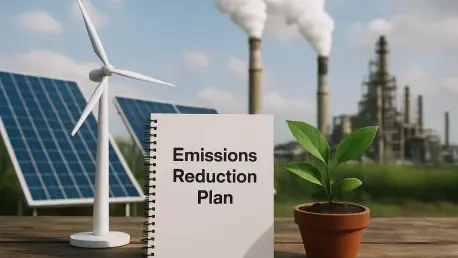In a pivotal move to combat persistent air pollution challenges, the Regional Air Quality Council (RAQC) in Colorado has introduced a forward-thinking “Blueprint” designed to curb emissions across multiple sectors. This strategic framework, slated for presentation to the Colorado Air Quality Control Commission (AQCC) in November, offers a detailed roadmap spanning the next decade to tackle severe ozone violations in the Northern Front Range, where levels consistently surpass the U.S. Environmental Protection Agency (EPA) threshold of 70 parts per billion. As air quality remains a pressing concern for public health and environmental sustainability in the region, this initiative marks a significant effort to address pollutants like nitrous oxides and volatile organic compounds, which are major contributors to ozone formation. The urgency of the situation is underscored by the complex interplay of local and external pollution sources that continue to hinder compliance with federal standards.
The Blueprint distinguishes itself as a set of recommendations rather than immediate mandates, aiming to guide future regulatory actions with a practical, phased approach. By targeting diverse areas such as oil and gas operations, transportation networks, consumer goods, and even indirect sources like warehouses and stadiums that attract heavy vehicle traffic, the plan casts a wide net over potential emissions contributors. RAQC Executive Director Mike Silverstein has highlighted the emphasis on planning over abrupt enforcement, framing the strategy as a balanced tool to achieve long-term environmental goals. This nuanced perspective sets the stage for a broader discussion on how to align ambitious air quality targets with the economic realities faced by businesses and communities alike, ensuring that the path forward is both actionable and sustainable.
Core Components of the Strategic Framework
Near-Term Priorities for Quick Results
The initial phase of the RAQC’s strategy focuses on actionable steps to be implemented by 2026, prioritizing data collection and the evaluation of existing tools to reduce emissions. This includes tightening permit limits for stationary pollution sources and enforcing current state plans, such as restrictions on gas-powered lawn equipment, which contribute to local air quality issues. Additionally, efforts are underway to study regulations around wellsite venting in the oil and gas sector, a significant source of pollutants in the region. For indirect sources like event venues and warehouses, the plan proposes incentivizing electric vehicle (EV) infrastructure, such as dedicated parking spots for EVs, to curb transportation-related emissions. This short-term focus aims to lay a solid foundation of data and early wins, ensuring that subsequent phases can build on informed, evidence-based decisions to maximize impact.
Beyond these immediate actions, the short-term bucket also emphasizes collaboration with local stakeholders to assess the feasibility of proposed measures before they are scaled up. For instance, gathering trip data around high-traffic locations like airports and colleges will help identify patterns and opportunities for reducing vehicle emissions through enhanced public transit access. This meticulous approach reflects a commitment to understanding the unique challenges of each sector, avoiding a one-size-fits-all solution that might overlook critical nuances. By focusing on pilot programs and incremental changes, such as promoting EV charging stations at large venues, the RAQC seeks to create momentum for broader adoption of emissions reduction strategies while minimizing disruption to existing operations. This careful balance between urgency and pragmatism is central to gaining widespread support for the initiative.
Mid-Range Goals for Consistent Advancement
Looking toward 2027 and 2028, the RAQC’s medium-term strategies aim to translate early assessments into concrete actions, with a target of measurable reductions by 2030. This phase includes voluntary emissions cuts for indirect sources, encouraging locations like warehouses to adopt practices that lower their environmental footprint without immediate regulatory pressure. Additionally, setting specific emissions targets for non-road equipment, such as farm machinery and golf carts, addresses often-overlooked contributors to pollution. Potential new rules under consideration include limits on commercial cooking emissions and restrictions on consumer products like hair spray or insecticides, which release volatile organic compounds. Electrification mandates for drilling rigs in the oil and gas sector further illustrate the plan’s intent to tackle industrial sources with innovative solutions.
This medium-term horizon also prioritizes adaptability, recognizing that ongoing data collection will refine the scope of proposed regulations. For example, feedback from pilot programs on EV infrastructure at high-traffic hubs will inform whether such measures should become mandatory or remain voluntary. The exploration of daily emissions limits offers another layer of precision, allowing for tailored restrictions that account for seasonal or operational variations in pollution output. By focusing on a mix of voluntary incentives and potential mandates, this phase seeks to build trust among stakeholders while steadily advancing toward federal air quality standards. The emphasis on sector-specific targets ensures that no area is left unaddressed, creating a comprehensive framework that can evolve based on real-world outcomes and technological advancements.
Long-Term Ambitions for Lasting Impact
The final tier of the RAQC’s Blueprint, targeting completion by 2030, introduces more ambitious measures that require extensive preparation and study to ensure their effectiveness. This includes the potential for mandatory regulations on indirect sources if voluntary efforts prove insufficient, pushing locations like stadiums and colleges to adopt stricter emissions controls. Innovative mobile-source reductions, such as the electrification of forklifts and other industrial equipment, are also under consideration, reflecting a commitment to cutting-edge solutions. These long-term initiatives aim to deliver significant, sustained improvements in air quality, addressing some of the most challenging sources of pollution through a combination of regulatory muscle and technological innovation.
Equally important in this phase is the focus on scalability and long-term planning to avoid unintended consequences. The RAQC recognizes that bold actions, such as mandatory rules for high-traffic locations, must be grounded in robust data to prevent economic hardship or operational inefficiencies. Partnerships with industry leaders will be key to developing feasible electrification programs for equipment like forklifts, ensuring that the transition is both practical and cost-effective. By reserving the most transformative changes for this later stage, the plan allows time for stakeholder input and technological advancements to shape implementation. This forward-looking vision underscores the importance of persistence and adaptability in addressing air quality challenges, setting a high bar for what can be achieved through sustained effort and collaboration.
Obstacles and Diverse Viewpoints
Balancing Economic Impacts with Environmental Gains
A significant hurdle facing the RAQC’s emissions reduction strategy is the tension between environmental objectives and the economic concerns of affected industries. Business groups, including the Colorado Motor Carriers Association, have voiced apprehension about measures like reducing vehicle trips to warehouses, arguing that such policies could strain operations without acknowledging existing efforts like fleet electrification. The potential costs of compliance, from retrofitting equipment to investing in new infrastructure, pose real challenges for sectors already navigating tight margins. These concerns highlight a broader debate about how to prioritize air quality improvements without placing undue burdens on businesses that form the backbone of the state’s economy, a balance that will be critical to the plan’s acceptance.
Further complicating this issue is the question of fairness in how regulations are applied across different sectors. Smaller businesses, for instance, may lack the resources to adapt as quickly as larger corporations, potentially creating disparities in compliance capabilities. The Colorado Petroleum Association has also raised the possibility of seeking EPA exemptions, pointing to uncontrollable pollution sources like wildfires as a reason to reconsider stringent local mandates. Addressing these economic anxieties will require targeted support, such as financial incentives or phased compliance timelines, to ensure that environmental progress does not come at the expense of livelihoods. Transparent dialogue between regulators and industry stakeholders remains essential to crafting solutions that are both equitable and effective in reducing emissions.
Debating the Reach of Local Regulations
Another critical point of contention is whether local efforts can meaningfully address ozone levels when significant pollution originates from sources beyond Colorado’s control, such as out-of-state emissions and natural phenomena like wildfires. RAQC leaders maintain a firm stance on pursuing actionable reductions within the state’s jurisdiction, emphasizing a goal-oriented approach over seeking federal exemptions as some other states have done. This commitment reflects a belief that consistent, localized action can still make a difference, even in the face of broader challenges, and serves as a call to focus on what can be directly influenced through policy and innovation.
However, skepticism persists among stakeholders about the ultimate effectiveness of these measures given the scale of external pollution factors. Cross-border emissions and international contributions to ozone formation create a complex landscape where local regulations may only address a fraction of the problem. This raises important questions about the need for regional or national cooperation to complement state-level initiatives, ensuring that efforts in Colorado are not undermined by uncontrollable variables. The debate underscores the limitations of localized policy in a global pollution context, pushing for a more integrated approach that could amplify the impact of the RAQC’s Blueprint through broader alliances and shared strategies.









